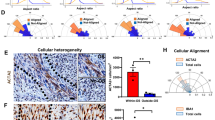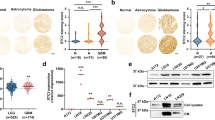Abstract
Invasion of brain tumor cells has made primary malignant brain neoplasms among the most recalcitrant to therapeutic strategies. We tested whether the secreted protein Slit2, which guides the projection of axons and developing neurons, could modulate brain tumor cell invasion. Slit2 inhibited the invasion of medulloblastoma cells in a variety of in vitro models. The effect of Slit2 was inhibited by the Robo ectodomain. Time-lapse videomicroscopy indicated that Slit2 reduced medulloblastoma invasion rate without affecting cell direction or proliferation. Both medulloblastoma and glioma tumors express Robo1 and Slit2, but only medulloblastoma invasion is inhibited by recombinant Slit2 protein. Downregulation of activated Cdc42 may contribute to this differential response. Our findings reinforce the concept that neurodevelopmental cues such as Slit2 may provide insights into brain tumor invasion.
This is a preview of subscription content, access via your institution
Access options
Subscribe to this journal
Receive 50 print issues and online access
$259.00 per year
only $5.18 per issue
Buy this article
- Purchase on Springer Link
- Instant access to full article PDF
Prices may be subject to local taxes which are calculated during checkout





Similar content being viewed by others
References
Astuti D, Da Silva NF, Dallol A, Gentle D, Martinsson T, Kogner P et al. (2004). Br J Cancer 90: 515–521.
Bashaw GJ, Kidd T, Murray D, Pawson T, Goodman CS . (2000). Cell 101: 703–715.
Corcoran A, Del Maestro RF . (2003). Neurosurgery 53: 174–184.
Dallol A, Da Silva NF, Viacava P, Minna JD, Bieche I, Maher ER et al. (2002). Cancer Res 62: 5874–5880.
Dallol A, Krex D, Hesson L, Eng C, Maher ER, Latif F . (2003a). Oncogene 22: 4611–4616.
Dallol A, Morton D, Maher ER, Latif F . (2003b). Cancer Res 63: 1054–1058.
Del Duca D, Werbowetski T, Del Maestro RF . (2004). J Neurooncol 67: 295–303.
Del Maestro RF, Shivers R, Mc Donald W, Del Maestro AGR . (2001). J Neurooncol 53: 87–98.
Etienne-Manneville S, Hall A . (2001). Cell 106: 489–498.
Etienne-Manneville S, Hall A . (2003). Nature 421: 753–756.
Fan X, Labrado JP, Hing H, Bashaw GJ . (2003). Neuron 40: 113–127.
Gilthorpe JD, Papantoniou E, Chedotal A, Lumsden A, Wingate RJT . (2002). Development 129: 4719–4728.
Gomes ER, Shantanu J, Gundersen GG . (2005). Cell 121: 451–463.
Jacobson PF, Jenkyn DJ, Papadimitriou JM . (1985). J Neuropathol Exp Neurol 44: 472–485.
Jen JC, Chan WM, Bosley TM, Wan J, Carr JR, Rub U et al. (2004). Science 304: 1509–1513.
Joki T, Machluf M, Atala A, Zhu J, Seyfried NT, Dunn IF et al. (2001). Nat Biotechnol 19: 35–39.
Keles GE, Berger MS, Srinivasan J, Kolstoe DD, Bobola MS, Silber JR . (1995). Oncol Res 7: 493–503.
Li HS, Chen JH, Wu W, Fagaly T, Zhou L, Yuan W et al. (1999). Cell 96: 807–818.
Louis DN, Pomeroy SL, Cairncross JG . (2002). Cancer Cell 1: 125–128.
Lundstrom A, Gallio M, Englund C, Steneberg P, Hemphala J, Aspenstrom P et al. (2004). Genes Dev 18: 2161–2171.
Luo L . (2000). Nat Rev Neurosci 1: 173–180.
Marillat V, Cases O, Nguyen-Ba-Charvet KT, Tessier-Lavigne M, Sotelo C, Chedotal A . (2002). J Comp Neurol 442: 130–155.
Marillat V, Sabatier C, Failli V, Matsunaga E, Sotelo C, Tessier-Lavigne M et al. (2004). Neuron 43: 69–79.
Mason HA, Susumu I, Corfas G . (2001). J Neurosci 21: 7654–7663.
Nguyen-Ba-Charvet KT, Picard-Riera N, Tessier-Lavigne M, Baron-Van Evercooren A, Sotelo C, Chedotal A . (2004). J Neurosci 24: 1497–1506.
Palazzo AF, Joseph HL, Chen Y-J, Dujardin DL, Alberts AS, Pfister KK et al. (2001). Curr Biol 11: 1536–1541.
Park KW, Morrison CM, Sorensen LK, Jones CA, Rao Y, Chien CB et al. (2003). Dev Biol 261: 251–267.
Prasad A, Fernandis AZ, Rao Y, Ganju RK . (2004). J Biol Chem 279: 9115–9124.
Raffel C . (2004). Neoplasia 6: 310–322.
Raffel C, Thomas GA, Tishler DM, Lassoff S, Allen JC . (1993). Neurosurgery 33: 301–305.
Raffel C, Ueki K, Harsh IV GR, Louis DN . (1995). Neurosurgery 36: 971–974.
Read TA, Sorensen DR, Mahesparan R, Enger PO, Timpl R, Olsen BR et al. (2001). Nat Biotechnol 19: 29–34.
Rossi MR, Huntoon K, Cowell JK . (2005). Gene 356: 85–90.
Rubin JB, Kung AL, Klein RS, Chan JA, Sun Y, Schmidt K et al. (2003). Proc Natl Acad Sci USA 100: 13513–13518.
Ruffini F, Arbour N, Blain M, Olivier A, Antel JP . (2004). Am J Pathol 165: 2167–2175.
Sanai N, Alvarez-Buylla A, Berger MS . (2005). N Engl J Med 353: 811–822.
Wang B, Xiao Y, Ding BB, Zhang N, Yuan X, Gui L et al. (2003). Cancer Cell 4: 19–29.
Werbowetski T, Bjerkvig R, Del Maestro RF . (2004). J Neurobiol 60: 71–88.
Werbowetski-Ogilvie TE, Agar NYA, Waldkircher de Oliveira RM, Faury D, Antel JP, Jabado N et al. (2006). Cancer Res 66: 1464–1472.
Wong K, Park HT, Wu JY, Rao Y . (2002). Curr Opin Genet Dev 12: 583–591.
Wong K, Ren XR, Huang YZ, Xie Y, Liu G, Saito H et al. (2001). Cell 107: 209–221.
Wu JY, Feng L, Park HT, Havlioglu N, Wen L, Tang H et al. (2001). Nature 410: 948–952.
Zhao Y, Zhang W, Kho Y, Zhao Y . (2004). Anal Chem 76: 1817–1823.
Acknowledgements
We thank Carmen Sabau, Roberta Waldkircher, and Samer Hussein for technical assistance (Montreal Neurological Institute, Montreal, Quebec). We also wish to thank Vinit Srivastava for providing the cerebellar tissue. TEWO is the recipient of a Canadian Institutes of Health Research (CIHR) Doctoral Research Award, MSS is the recipient of a Jeanne Timmins Costello Fellowship, NJ is a recipient of a Chercheur Boursier Salary award from Fonds de la Recherche en Sante du Quebec (FRSQ) and AAL is a recipient of the Terry Fox Studentship from the National Cancer Institute of Canada. RFDM holds the William Feindel Chair of Neurooncology and is a Killam Scholar at the Montreal Neurological Institute. This work was supported by the Goals for Lily and the Alex Pavanel Family, the Franco Di Giovanni, the Barbara Jacobson and Carol Cuthbertson, the Raymonde and Tony Boeckh Brain Tumor Research Funds, The Brain Tumour Foundation of Canada and the Maggie De Fontes Foundation.
Author information
Authors and Affiliations
Corresponding authors
Additional information
Supplementary Information accompanies the paper on the Oncogene website (http://www.nature.com/onc)
Rights and permissions
About this article
Cite this article
Werbowetski-Ogilvie, T., Seyed Sadr, M., Jabado, N. et al. Inhibition of medulloblastoma cell invasion by Slit. Oncogene 25, 5103–5112 (2006). https://doi.org/10.1038/sj.onc.1209524
Received:
Revised:
Accepted:
Published:
Issue Date:
DOI: https://doi.org/10.1038/sj.onc.1209524



